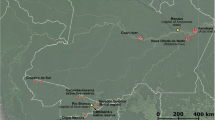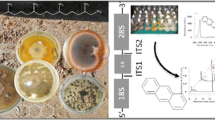Abstract
This study was conducted to generate information regarding the diversity of fungi inhabiting creosote-treated wood in a storage yard for crosstie wastes in Gwangmyeong, Korea. Additionally, the resistance to polycyclic aromatic hydrocarbons (PAHs) of indigenous fungi that mainly occupy creosote-treated wood was evaluated. We isolated fungi from the surface and inner area of crosstie wastes and identified them using a combination of traditional methods and molecular techniques. Overall, 179 isolates including 47 different species were isolated from 240 sampling sites. The identified fungal species included 23 ascomycetes, 19 basidiomycetes, and 5 zygomycetes. Three species, Alternaria alternata, Irpex lacteus, and Rhizomucor variabilis, were the most frequently isolated ascomycetes, basidiomycetes, and zygomycetes, respectively. The results of this study showed that there was a large difference in the fungal diversity between the surface and the inner area. Additionally, zygomycetes and ascomycetes were found to have a greater tolerance to PAHs than basidiomycetes. However, two basidiomycetes, Heterobasidion annosum and Schizophyllum commune, showed very high resistance to PAHs, even in response to the highest concentration (1,000 ppm), which indicates that these species may play a role in the degradation of PAHs.

Similar content being viewed by others
References
Altschul SF, Boguski MS, Gish W, Wootton JC (1994) Issues in searching molecular sequence databases. Nat Genet 6:119–129
Arenz BE, Held BW, Jurgens JA, Farrell RL, Blanchette RA (2006) Fungal diversity in soils and historic wood from the Ross Sea region of Antarctica. Soil Biol Biochem 38:3057–3064
Atagana HI (2003) Bioremediation of creosote-contaminated soil: a pilot-scale land farming evaluation. World J Microbiol Biotechnol 19:571–581
Atagana HI, Haynes RJ, Wallis FM (2006) Fungal bioremediation of creosote-contaminated soil: a laboratory scale bioremediation study using indigenous soil fungi. Water Air Soil Pollut 172:201–219
Balajee SA, Borman AM, Brandt ME, Cano J, Cuenca-Estrella M, Dannaoui E, Guarro J, Haase G, Kibbler CC, Meyer W, O’Donnell K, Petti CA, Rodriguez-Tudela JL, Sutton D, Velegraki A, Wickes BL (2009) Sequence-based identification of Aspergillus, Fusarium, and Mucorales species in the clinical mycology laboratory: where are we and where should we go from here? J Clin Microbiol 47:877–884
Bamforth SM, Singleton I (2005) Bioremediation of polycyclic aromatic hydrocarbons: current knowledge and future directions. J Chem Technol Biotechnol 80:723–736
Blumenthal CZ (2004) Production of toxic metabolites in Aspergillus niger, Aspergillus oryzae, and Trichoderma reesei: justification of mycotoxin testing in food grade enzyme preparations derived from the three fungi. Regul Toxicol Pharmacol 39:214–228
Butcher JA (1968) The ecology of fungi infecting untreated and preservative treated sapwood of Pinus radiata. Can J Bot 46:1577–1589
Cajthaml T, Erabanová P, Kollmann A, Novotnỳ Č, Šašek V, Mougin C (2008) Degradation of PAHs by ligninolytic enzymes of Irpex lacteus. Folia Microbiol 53:289–294
Camargo JA (1993) Must dominance increase with the number of subordinate species in competitive interactions? J Theor Biol 161:537–542
Collins PJ, Kotterman MJJ, Field JA, Dobson ADW (1996) Oxidation of anthracene and benzo[a]pyrene by laccases from Trametes versicolor. Appl Environ Microbiol 62:4563–4567
Cortés-Espinosa DV, Fernández-Perrino FJ, Arana-Cuenca A, Esparza-García F, Loera O, Rodríguez-Vázquez RR (2006) Selection and identification of fungi isolated from sugarcane bagasse and their application for phenanthrene removal from soil. J Environ Sci Heal A 41:475–486
Duncan CG, Lombard EF (1965) Fungi associated with principal decays in wood products in the United States. Report No. WO-4. Department of Agriculture, Washington, DC, USA. For. Prod. Lab. USDA Forest Service, Madison
Freeman DJ, Cattell FCR (1990) Wood burning as a source of atmospheric polycyclic aromatic hydrocarbons. Environ Sci Technol 24:1581–1585
Galli E, Brancaleoni E, Di Mario F, Donati E, Frattoni M, Polcaro CM, Rapanà P (2008) Mycelium growth and degradation of creosote-treated wood by basidiomycetes. Chemosphere 72:1069–1072
Giraffa G, Neviani E (2001) DNA-based, culture-independent strategies for evaluating microbial communities in food-associated ecosystems. Int J Food Microbiol 67:19–34
Han MJ, Choi HT, Song HG (2004) Degradation of phenanthrene by Trametes versicolor and its laccase. J Microbiol 42:94–98
Hibbett DS, Binder M, Bischoff JF, Blackwell M, Cannon PF, Eriksson OE, Huhndorf S, James T, Kirk PM, Lücking R, Lumbsch T, Lutzoni F, Matheny PB, McLaughlin DJ, Powell MJ, Redhead S, Schoch CL, Spatafora JW, Spalpers JA, Vilgalys R, Aime MC, Aptroot A, Bauer R, Begerow D, Benny GL, Castlebury LA, Crous PW, Dai Y-C, Gams W, Geiser DM, Griffith GW, Gueidan C, Hawksworth DL, Hestmark G, Hosaka K, Humber RA, Hyde K, Ironside JE, Kõljalg U, Kurtzman CP, Larsson K-H, Lichtwardt R, Longcore J, Miadlikowska J, Miller A, Moncalvo J-M, Mozley-Standridge S, Oberwinkler F, Parmasto E, Reeb V, Rogers JD, Roux C, Ryvarden L, Sampaio JP, Schüssler A, Sugiyama J, Thorn RG, Tibell L, Untereiner WA, Walker C, Wang Z, Weir A, Weiss M, White MM, Winka K, Yao Y, Zhang N (2007) A higher-level phylogenetic classification of the Fungi. Mycol Res 111:504–547
Horton TR, Bruns TD (2001) The molecular revolution in ectomycorrhizal ecology; peeking into the black box. Mol Ecol 10:1855–1871
Hunt J, Boddy L, Randerson PF, Rogers HJ (2004) An evaluation of 18S rDNA approaches for the study of fungal diversity in grassland soils. Microb Ecol 47:385–395
Kamei I, Suhara H, Kondo R (2005) Phylogenetical approach to isolation of white-rot fungi capable of degrading polychlorinated dibenzo-p-dioxin. Appl Microbiol Biotechnol 69:358–366
Kernaghan G, Sigler L, Khasa D (2003) Mycorrhizal and root endophytic fungi of containerized Picea glauca seedlings assessed by rDNA sequence analysis. Microb Ecol 45:128–136
Kim G-H, Lim YW, Song Y-S, Kim J-J (2005) Decay fungi from playground wood products in service using 28S rDNA sequence analysis. Holzforsch 59:459–466
Kim G-H, Lim YW, Choi YS, Kim M-J, Kim J-J (2009) Primary and secondary decay fungi on exposed pine tree logs in the forest. Holzforsch 63:633–638
Kwasna H, Ward E, Bateman GL (2006) Phylogenetic relationships among zygomycetes from soil based on ITS1/ITS2 rDNA sequences. Mycol Res 110:501–510
Lamar RT, Main LM, Dietrich DM, Glaser JA. (1999) Screening of fungi for soil remediation potential. In: Kral DM, Viney MK (eds) Bioremediation of contaminated soils. SSSA Special Publication Number 37. American Society of Agronomy Inc., Crop Science Society of America Inc, Soil Science Society of America Inc., Madison, Wisconsin, pp 437–456
Landeweert R, Leeflang P, Kuyper TW, Hoffland E, Rosling A, Wernars K, Smit E (2003) Molecular identification of ectomycorrhizal mycelium in soil. Appl Environ Microbiol 69:327–333
Launen L, Pinto L, Wiebe C, Kiehlmann E, Moore M (1995) The oxidation of pyrene and benzo[a]pyrene by non-basidiomycete soil fungi. Can J Microbiol 41:477–488
Lee JC-I, Cole M, Linacre A (2000) Identification of members of the genera Panaeolus and Psilocybe by a DNA test: a preliminary test for hallucinogenic fungi. Forensic Sci Int 112(2–3):123–133
Lim LH, Harrison RM, Harrad S (1999) The contribution of traffic to atmospheric concentrations of polycyclic aromatic hydrocarbons. Environ Sci Technol 33:3538–3542
Lim YW, Kim J-J, Chedgy R, Morris PI, Breuil C (2005) Fungal diversity from western red cedar fences and their resistance to β-thujaplicin. Anton van Leeuwenhoek 87:109–117
Lutzoni F, Kauff F, Cox JC, McLaughlin D, Celio G, Dentinger B, Padamsee M, Hibbett D, James TY, Baloch E, Grube M, Reeb V, Hofstetter V, Schoch C, Arnold AE, Miadlikowska J, Spatafora J, Johnson D, Hambleton S, Crockett M, Shoemaker R, Sung G-H, Lücking R, Lumbsch T, O’Donnell K, Binder M, Diederich P, Ertz D, Gueidan C, Hansen K, Harris RC, Hosaka K, Lim YW, Matheny B, Nishida H, Pfister D, Rogers J, Rossman A, Schmitt I, Sipman H, Stone J, Sugiyama J, Yahr R, Vilgalys R (2004) Assembling the fungal tree of life: progress, classification, and evolution of subcellular traits. Am J Bot 91:1446–1480
Matheny PB, Wang Z, Binder M, Curtis JM, Lim YW, Nilsson RH, Hughes KW, Hofstetter V, Ammirati JF, Schoch C, Langer E, Langer G, McLaughlin DJ, Wilson AW, Froslev T, Ge ZW, Kerrigan RW, Kerrigan R, Slot J, Yang ZL, Baroni TJ, Fischer M, Hosaka K, Matsuura K, Seidl M, Vauras J, Hibbett DS (2007) Contributions of rpb2 and tef1 to the phylogeny of mushrooms and allies (Basidiomycota, Fungi). Mol Phylogenet Evol 43:430–451
Meyer W, Gams W (2003) Delimitation of Umbelopsis (Mucorales, Umbelopsidaceae fam. Nov.) based on ITS sequence and RELP data. Mycol Res 107:339–350
Morgan P, Lewis ST, Watkinson RJ (1991) Comparison of abilities of white-rot fungi to mineralize selected xenobiotic compounds. Appl Microbiol Biotechnol 34:693–696
Mueller JG, Chapman PJ, Pritchard PH (1989) Creosote contaminated sites: their potential for bioremediation. Environ Sci Technol 23:197–1201
Potin O, Rafin C, Veignie E (2004) Bioremediation of an aged polycyclic aromatic hydrocarbons (PAHs)-contaminated soil by filamentous fungi isolated from the soil. Int Biodeterior Biodegrad 54:45–52
Rabinovich ML, Bolobova AV, Vasil’chenko LG (2004) Fungal decomposition of natural aromatic structures and xenobiotics: a review. Appl Biochem Microbiol 40:1–17
Ravelet C, Krivobook S, Sage L, Steiman R (2000) Biodegradation of pyrene by sediment fungi. Chemosphere 40:557–563
Samuels GJ, Dodd SL, Lu B-S, Petrini O, Schroers H-J, Druzhinina IS (2006) The Trichoderma koningii aggregate species. Stud Mycol 56:67–133
Saraswathy A, Hallberg R (2002) Degradation of pyrene by indigenous fungi from a former gasworks site. FEMS Microbiol Lett 210:227–232
Schmidt O, Moreth U (2002) Data bank of rDNA-ITS sequences from building-rot fungi for their identification. Wood Sci Technol 36:429–433
Vilgalys R, Hester M (1990) Rapid genetic identification and mapping of enzymatically amplified ribosomal DNA from several Cryptococcus species. J Bacteriol 172:4238–4246
Vyas BRM, Volc J, Sasek V (1994) Ligninolytic enzymes of selected white rot fungi cultivated on wheat straw. Folia Microbiol 39:235–240
White TJ, Bruns TD, Lee S, Taylor JW (1990) Amplification and direct sequencing of fungal ribosomal RNA genes for phylogenetics. In: Innis MA, Gelfand DH, Sninsky JJ, White TJ (eds) PCR protocols: a guide to methods and applications. Academic Press, New York, pp 315–322
Zabel RA, Moore RA (1958) Relative effectiveness of several oil-soluble wood preservatives. For Prod J 8:258–263
Zabel RA, Lombard FF, Wang CJK, Terracina F (1985) Fungi associated with decay in treated southern pine utility poles in the eastern United States. Wood Fiber Sci 17:75–91
Acknowledgments
This work was supported by National Research Foundation of Korea Grant funded by the Korean Government (KRF-2008-331-F00029) and by Technology Development Program (309016-5) for Agriculture and Forestry, Ministry for Food, Agriculture, Forestry and Fisheries, Republic of Korea.
Author information
Authors and Affiliations
Corresponding author
Rights and permissions
About this article
Cite this article
Kim, MJ., Lee, H., Choi, YS. et al. Diversity of fungi in creosote-treated crosstie wastes and their resistance to polycyclic aromatic hydrocarbons. Antonie van Leeuwenhoek 97, 377–387 (2010). https://doi.org/10.1007/s10482-010-9416-6
Received:
Accepted:
Published:
Issue Date:
DOI: https://doi.org/10.1007/s10482-010-9416-6




